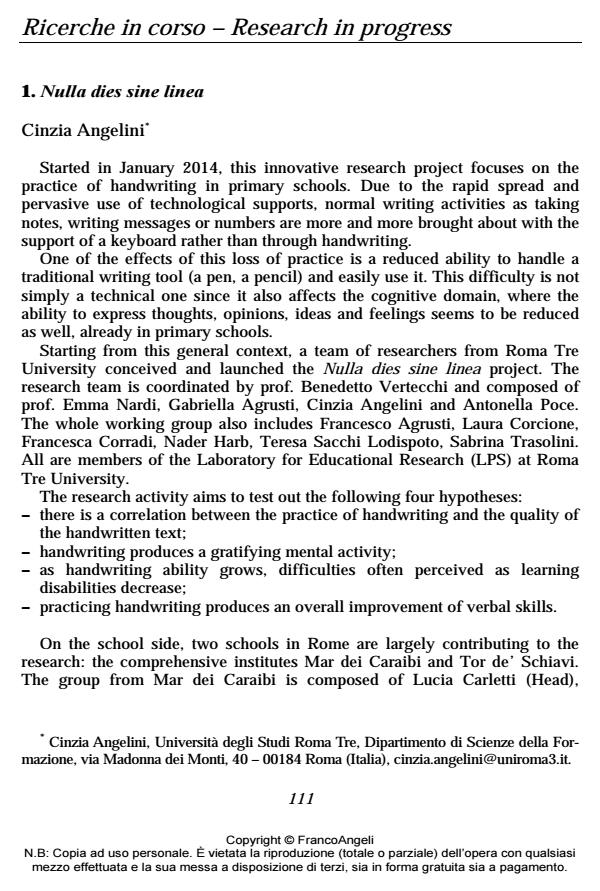Research in progress
Journal title CADMO
Author/s A cura della Redazione
Publishing Year 2014 Issue 2014/1
Language Italian Pages 9 P. 111-119 File size 34 KB
DOI 10.3280/CAD2014-001010
DOI is like a bar code for intellectual property: to have more infomation
click here
Below, you can see the article first page
If you want to buy this article in PDF format, you can do it, following the instructions to buy download credits

FrancoAngeli is member of Publishers International Linking Association, Inc (PILA), a not-for-profit association which run the CrossRef service enabling links to and from online scholarly content.
- Anderson, J., Rainie, L. (2013), “Millennials Will Benefit and Suffer Due to Their Hyperconnected Lives”, Pew Internet & American Life Project report, February, http://pewinternet.org/Reports/2012/Hyperconnected-lives.aspx, u.a. 15.04.2014.
- Cingle, D., Sundar S. (2012), “Texting, Techspeak, and Tweens: The Relationship between Text Messaging and English Grammar Skills”, New Media & Society, May 11, http://nms.sagepub.com/content/early/2012/05/10/1461444812442927, u.a. 15.04.2014.
- Cotroneo, R. (2014), “Il trapassato remoto? Archiviato”, Sette-Corriere della Sera, 28/3/2014.
- Cristal, D. (2001), Language and the Internet. Cambridge (UK): OUP.
- Fang-Yi, F., Wang, K., Klausner, M. (2013), “Rethinking Students’ Self Regulation and Sustained Attention: Does Text messaging during Class Influence Cognitive learning?”, Communication Education, 4 April, http://thomas-hersey.wiki.uml.edu/file/view/Rethinking_College_Student’s_Self-Regulation.pdf, u.a. 15.04.2014.
- Henry, J. (2013), Art of Essay Writing Damaged by Twitter and Facebook, 20 January, http://www.telegraph.co.uk/technology/social-media/9813109/Art-of-essay-writingdamaged-by-Twitter-and-Facebook-Cambridge-don-warns.html, u.a. 15.04.2014.
- Junco, R. (2011), “Too Much Face and not Enough Books: the Relationship between Multiple Indices of Facebook Use and Academic Performance”, Computers in Human Behaviour, 28, 1, pp. 187-198.
- Junco, R., Cotten, S.R. (2012), “No A 4 U: The Relationship between Multitasking and Academic Performance”, Computers & Education, 59, 2, September, pp. 505-514, http://dx.doi.org/10.1016/j.compedu.2011.12.023, u.a. 27.11.2013.
- Kirschner, P., Karpinski, A. (2010), “Facebook and Academic Performance”, Computers in Human Behavior, 26, 6, November, pp. 1237-1245, http://dx.doi.org/10.1016/j.chb.2010.03.024, u.a. 15.04.2014.
- Longcamp, M., Boucard, C., Gilhodes, J.C., Anton, J.L., Roth, M., Nazarian B. et al. (2008), “Learning through Hand or Typewriting Influences Visual Recognition of New Graphic Shapes: Behavioural and Functional Imaging Evidence”, Journal of Cognitive Neuroscience, 20, pp. 802-815. Longcamp, M., Hlushchuk, Y., Hari, R. (2011), “What differs in Visual Recognition of Handwritten vs Printed Letters? An FMRI Study”, Human Brain Mapping, 32, pp. 1250-1259.
- Myers, J. (2012), “Texting Affects Ability to interpret Words”, Utoday, https://www.ucalgary.ca/news/utoday/february17-2012/texting, u.a. 15.04.2014.
- Ritchel, M. (2011), A Silicon Valley School That Doesn’t Compute, 22 October, http://www.nytimes.com/2011/10/23/technology/at-waldorf-school-in-silicon-valley-technology-canwait.
- html?pagewanted=all&_r=0, u.a. 15.04.2014.
- Rosen, L.D., Carrier, L., Cheever, N.A. (2013), “Facebook and Texting Made Me Do it: Media-induced Task-switching while Studying”, Computers in Human Behavior, pp. 948-958, http://dx.doi.org/10.1016/j.chb.2012.12.001, u.a. 27/11/2013.
- Spitzer, M. (2013), “To Swipe or not to Swipe? The Question in Present-day Education”, Trends in Neuroscience and Education, http://www.sciencedirect. com/science/journal/22119493, u.a. 22.04.2014.
- Suto, I. (2012), “What are the Impacts of Qualifications for 16 to 19 Year Olds on Higher Education? A Survey of 633 University Lecturers”, Cambridge Assessment, April, http://www.cambridgeassessment.org.uk/images/116010-cambridge-assessment-heresearch-survey-of-lecturers-executive-summary.pdf.
- Tan, LH., Xu, M., Chang, C.Q., Siok, W.T. (2013), “China’s Language Input System in the Digital Age Affects Children’s Reading Development”, Proceedings of the National Academy of Sciences, 111, pp. 1119-1123.
- Truong, K. (2010), “Student Smartphones Use Doubles: Instant Messaging Loses Favour”, in The Higher Education Chronicle, 17 June, http://chronicle.com/blogs/ wiredcampus/studentsmartphone-use-doubles-instant-messaging-loses-favor/24876, u.a. 15.04.2014.
- Vertecchi, B. (2014), “Interrogantibus libenter respondeat”, 4 aprile, http:// minimaeducationis.wordpress.com/author/benever/, u.a. 22.04.2014.
A cura della Redazione, Ricerche in corso in "CADMO" 1/2014, pp 111-119, DOI: 10.3280/CAD2014-001010